John Sauder, Global Programmes Director
As we celebrated forty years of God’s faithfulness to EMI in 2022, we also began evaluating our past.
The Africa Projects Evaluation Initiative was developed to measure former EMI projects across three categories of performance:
Past outputs within our core value of Design, present resulting outcomes aligned with our Mission, and the impacts of restoration that define our future Vision.
This initiative included a range of 160 projects completed within 24 countries of Africa and the Middle East between 2017-2021. This represents over half of EMI’s total project work in that timeframe from six different EMI offices.
EMI projects and offices within
Africa and the Middle East
(2017-2021)

Above: Besides these four EMI offices, EMI USA and EMI Canada had also serviced a portion of the 160 projects evaluated in the study.
Design Outputs
Measuring our past design outputs included descriptors like project location, type and services provided.
Within this set of 160 projects, EMI provided more than one type of service for some projects. Overall, EMI performed a total of 291 service efforts ranging from pre-design to construction to help our clients realize their ministry visions.

Education projects represented the largest number of projects completed across all regions at 33% of the total. And fully 40% of all eastern region projects were education projects, which is a response to the needs of communities and the Church there.
In evaluating design performance, questions around the design approach and product were asked: How were teams assembled? How much time was spent on design? Was cost planning included? Thousands of data points were collected across dozens of evaluation criteria and we’re examining the inter-relationships.
One set of criteria looks at the relationship between services provided and project proximity to the nearest EMI office.
Project proximity and EMI services within
Africa and the Middle East
(2017-2021)

The dataset highlights several trends:
- 50% of projects are within 150km (1-day round-trip access) of an EMI office location.
- Projects within this range were nearly twice as likely to receive EMI services beyond the concept design stage.
- Nearly 70% of the projects outside of a country with an established EMI office were led by an EMI office located outside the region.
Further analysing these types of relationships could help to inform how we develop projects, what services we provide, and other strategic decisions that align with our core values and the needs of our ministry partners.
Built Outcomes
The outcomes of constructed projects were evaluated through in-person site visits across 24 locations.
During these visits everything from the quality of the construction to building performance and the number of beneficiaries being served was documented.
Staff interviews also provided direct feedback on project outcomes, both constructive and encouraging. One pediatrician from an EMI-designed hospital commented,
“…another benefit is the lighting and ventilation that makes rounds and patient care so much more pleasant for everyone.

Above: The EMI design team’s consideration of sun-shading for this project in the Sahel climatic zone improved environmental performance outcomes. Photo by Andre Olwagen.
“Before, nurses would need to bring patients outside to look for IVs in the sunlight, but now they have well-lit treatment rooms and procedural areas where it's much easier to place IVs quickly and sterilely.”
Stories of Impact
A further benefit to on-site visits provided the opportunity to spend time with ministry leadership in the built environments of completed projects.
From these deeper conversations, stories of lives being transformed often emerged. One leader spoke of the effects not only on those the project was intended to serve, but to those providing the service.
“…our new staff often become emotional during orientation because they feel so valued by the design of the spaces.”

Above: Adaptation of an outdoor meeting area for private work within an EMI-designed administration building. Photo by Andre Olwagen.
These stories demonstrate a measure of God’s spirit working to bring restoration in the lives of people through designs that reflect his glory and goodness.
By dedicating time and resources to measuring our past, we hope to become more equipped in the present, and more prepared for the opportunities that lie in front of us.
As we listen to our partners in ministry and learn from our observations, may we also be strengthened in the hope of our calling.


